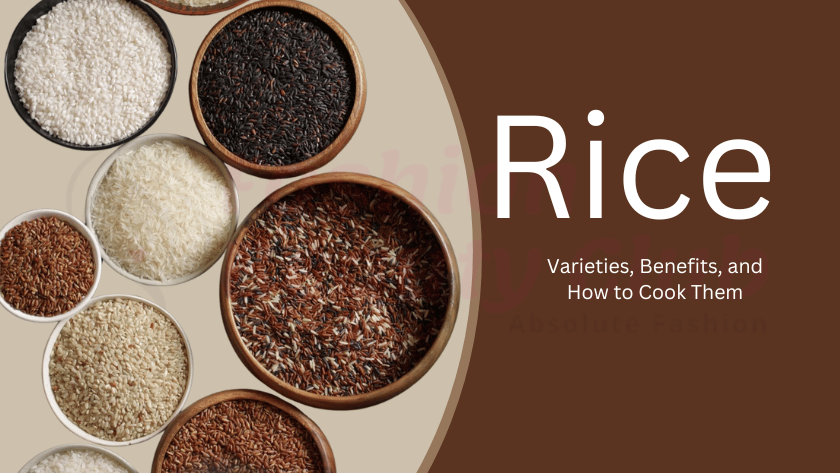Introduction
Rice is one of the most popular staple foods worldwide, enjoyed in various cuisines. 🌾 It comes in different varieties, each with a unique taste, texture, and nutritional value. Whether you love fluffy white rice, aromatic basmati, or nutritious brown rice, there’s a type for everyone. Let’s explore the different types of rice, their benefits, and how you can cook them perfectly. 👨🍳
Types of Rice and Their Benefits
1️⃣ White Rice
✅ Description: White rice is the most commonly consumed rice, with its husk, bran, and germ removed.
✅ Benefits: Easy to digest, quick to cook, and pairs well with various dishes.
✅ How to Cook: Rinse the rice, add 1 cup of rice to 2 cups of water, and cook for 15 minutes.
2️⃣ Brown Rice
✅ Description: Brown rice is a whole grain with its bran layer intact, making it more nutritious.
✅ Benefits: Rich in fiber, vitamins, and minerals; supports digestion and heart health. ❤️
✅ How to Cook: Soak for 30 minutes, use 2.5 cups of water for 1 cup of rice, and cook for 40 minutes.
3️⃣ Basmati Rice
✅ Description: A long-grain, aromatic rice variety mainly grown in India and Pakistan. 🍛
✅ Benefits: Low in fat, has a distinct fragrance, and is great for weight management.
✅ How to Cook: Rinse well, soak for 20 minutes, use 1.5 cups of water per cup of rice, and cook for 12 minutes.
4️⃣ Jasmine Rice
✅ Description: A fragrant, soft, and slightly sticky rice variety from Thailand.
✅ Benefits: Provides energy, has a pleasant aroma, and complements Asian dishes.
✅ How to Cook: Rinse thoroughly, use 1.5 cups of water for 1 cup of rice, and cook for 15 minutes.
5️⃣ Black Rice (Forbidden Rice)
✅ Description: A deep purple-black rice known for its high antioxidant content.
✅ Benefits: Boosts immunity, rich in iron, and promotes heart health.
✅ How to Cook: Soak for an hour, use 2 cups of water for 1 cup of rice, and cook for 30 minutes.
6️⃣ Red Rice
✅ Description: A reddish whole grain rice variety loaded with nutrients.
✅ Benefits: Rich in antioxidants, helps control blood sugar, and supports digestion.
✅ How to Cook: Soak for 30 minutes, use 2 cups of water per cup of rice, and cook for 40 minutes.
7️⃣ Arborio Rice
✅ Description: A short-grain rice used mainly for risotto and creamy dishes. 🍲
✅ Benefits: High in carbohydrates, gives a creamy texture to dishes.
✅ How to Cook: No need to rinse, cook slowly with broth, stirring frequently.
8️⃣ Wild Rice
✅ Description: Technically a grass, wild rice is chewy and full of nutrients.
✅ Benefits: High in protein, gluten-free, and supports muscle growth. 💪
✅ How to Cook: Soak overnight, use 3 cups of water per cup of rice, and cook for 45 minutes.
Why Should You Eat Rice? 🤔
✅ Energy Booster: Rice is rich in carbohydrates, giving your body instant energy.
✅ Gluten-Free: Perfect for those with gluten intolerance or celiac disease.
✅ Good for Digestion: Brown, red, and black rice have high fiber, promoting gut health.
✅ Versatile: Can be used in countless dishes like biryani, risotto, sushi, and desserts.
✅ Nutrient-Rich: Provides essential vitamins, minerals, and antioxidants.
How to Cook Perfect Rice Every Time 🍽️
🔹 Rinse the rice before cooking to remove excess starch and prevent stickiness.
🔹 Use the right water ratio (typically 2 cups of water for 1 cup of rice).
🔹 Bring to a boil, then simmer on low heat for even cooking.
🔹 Cover with a lid and let it steam for a few minutes after turning off the heat.
🔹 Fluff with a fork before serving to separate the grains.
Conclusion
Rice is a delicious, nutritious, and versatile food that can be enjoyed in numerous ways. 🍛 Whether you prefer white, brown, black, or jasmine rice, each type has its own unique benefits. Including rice in your diet can help improve digestion, provide energy, and offer a variety of flavors to your meals. Try out different rice varieties and discover your favorite today! 😋
Do you have a favorite type of rice? Let us know in the comments! ⬇️




